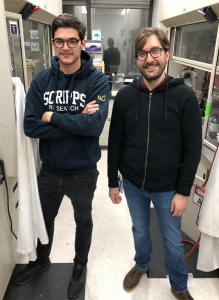
Study Authors Francisco Battiti and Alessandro Bonifazi
Featured Paper of the Month – December 2020
In this study, starting from our highly selective and potent D3R agonist 5 , we further investigated the chemical space around the linker portion of the molecule, via insertion of a hydroxyl substituent and ring-expansion of the trans cyclopropyl moiety into a trans -cyclohexyl scaffold. Moreover, inspired by previous observations that an inversion in stereochemistry for the PP was necessary to transition from orthosteric to bitopic binding mode, we explored the chiral requirements of (+)-(4aR,10bR)-2 (potent, non-selective D3R agonist) by synthesizing and resolving bitopic analogues in all the cis and trans combinations of its 9-methoxy-3,4,4a,10b-tetrahydro-2H ,5H -chromeno[4,3-b ][1,4]oxazine scaffold. Investigation around the linker chirality and chemical space allowed us to identify unique pharmacological profiles depending exclusively from the linker’s substitutions and rigidity: i) cyclopropyl-containing linker (compound 5 ) is the privileged structure for achieving high D3 R affinity and selectivity, but it is an important synthon for D1 R recognition around which directing D1R-D3R multitarget drug design; ii) cyclohexyl-containing linker (compound 10 ) is still well-tolerated at D3R and significant subtype selectivity, despite a slight loss in overall affinity; iii) hydroxylsubstituted linker (11 ) causes loss in D3R affinity, maintains a moderate subtype selectivity over D2R, but it is responsible for an increased μOR affinity, not different from the D3R sub-micromolar Ki . We identified essential structural information to understand the differences between orthosteric and bitopic ligand-receptor binding interactions, discriminate D3R active and inactive states and assist multitarget receptor recognition. Exploring stereochemical complexity and developing extended D3R SAR from this new library complements previously described SAR and inspires future structural and computational biology investigation. Moreover, the expansion of chemical space characterization for D3R agonism may be utilized in machine learning and artificial intelligence (A.I.)-based drug design, in the future.
Publication Information
Exception That Proves the Rule: Investigation of Privileged Stereochemistry in Designing Dopamine D3R Bitopic Agonists Journal Article
In: ACS Medicinal Chemistry Letters, vol. 11, no. 10, pp. 1956–1964, 2020.
